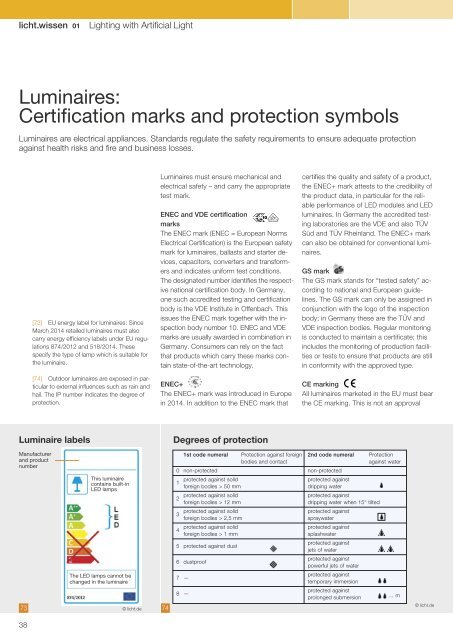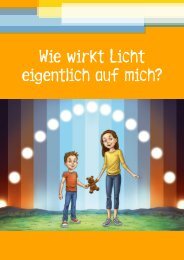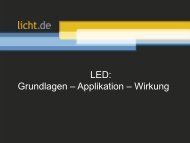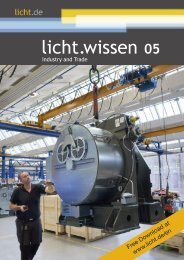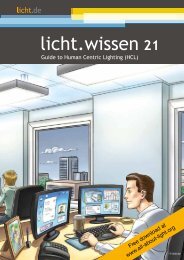licht.wissen No. 01 "Lighting with Artificial Light"
Booklet 1 is intended for all those who want to delve into the topic of light and lighting or wish to familiarize themselves with the basics of lighting technology. It also helps to make a decision in the field of lighting. Free Download at www.licht.de/en
Booklet 1 is intended for all those who want to delve into the topic of light and lighting or wish to familiarize themselves with the basics of lighting technology. It also helps to make a decision in the field of lighting. Free Download at www.licht.de/en
You also want an ePaper? Increase the reach of your titles
YUMPU automatically turns print PDFs into web optimized ePapers that Google loves.
<strong>licht</strong>.<strong>wissen</strong> <strong>01</strong><br />
<strong>Lighting</strong> <strong>with</strong> <strong>Artificial</strong> Light<br />
Luminaires:<br />
Certification marks and protection symbols<br />
Luminaires are electrical appliances. Standards regulate the safety requirements to ensure adequate protection<br />
against health risks and fire and business losses.<br />
[73] EU energy label for luminaires: Since<br />
March 2<strong>01</strong>4 retailed luminaires must also<br />
carry energy efficiency labels under EU regulations<br />
874/2<strong>01</strong>2 and 518/2<strong>01</strong>4. These<br />
specify the type of lamp which is suitable for<br />
the luminaire.<br />
[74] Outdoor luminaires are exposed in particular<br />
to external influences such as rain and<br />
hail. The IP number indicates the degree of<br />
protection.<br />
Luminaires must ensure mechanical and<br />
electrical safety – and carry the appropriate<br />
test mark.<br />
ENEC and VDE certification<br />
marks<br />
The ENEC mark (ENEC = European <strong>No</strong>rms<br />
Electrical Certification) is the European safety<br />
mark for luminaires, ballasts and starter devices,<br />
capacitors, converters and transformers<br />
and indicates uniform test conditions.<br />
The designated number identifies the respective<br />
national certification body. In Germany,<br />
one such accredited testing and certification<br />
body is the VDE Institute in Offenbach. This<br />
issues the ENEC mark together <strong>with</strong> the inspection<br />
body number 10. ENEC and VDE<br />
marks are usually awarded in combination in<br />
Germany. Consumers can rely on the fact<br />
that products which carry these marks contain<br />
state-of-the-art technology.<br />
ENEC+<br />
The ENEC+ mark was introduced in Europe<br />
in 2<strong>01</strong>4. In addition to the ENEC mark that<br />
certifies the quality and safety of a product,<br />
the ENEC+ mark attests to the credibility of<br />
the product data, in particular for the reliable<br />
performance of LED modules and LED<br />
luminaires. In Germany the accredited testing<br />
laboratories are the VDE and also TÜV<br />
Süd and TÜV Rheinland. The ENEC+ mark<br />
can also be obtained for conventional luminaires.<br />
GS mark<br />
The GS mark stands for “tested safety” according<br />
to national and European guidelines.<br />
The GS mark can only be assigned in<br />
conjunction <strong>with</strong> the logo of the inspection<br />
body; in Germany these are the TÜV and<br />
VDE inspection bodies. Regular monitoring<br />
is conducted to maintain a certificate; this<br />
includes the monitoring of production facilities<br />
or tests to ensure that products are still<br />
in conformity <strong>with</strong> the approved type.<br />
CE marking<br />
All luminaires marketed in the EU must bear<br />
the CE marking. This is not an approval<br />
Luminaire labels<br />
Degrees of protection of protection<br />
Manufacturer<br />
and product<br />
number<br />
38<br />
This luminaire<br />
contains built-in<br />
LED lamps<br />
The LED lamps cannot be<br />
changed in the luminaire<br />
73 © <strong>licht</strong>.de 74<br />
1st code numeral Protection against foreign 2nd code numeral Protection<br />
bodies and contact<br />
against water<br />
0 non-protected non-protected<br />
1<br />
2<br />
3<br />
4<br />
protected against solid protected against<br />
foreign bodies > 50 mm<br />
dripping water<br />
protected against solid protected against<br />
foreign bodies > 12 mm<br />
dripping water when 15° tilted<br />
protected against solid protected against<br />
foreign bodies > 2,5 mm<br />
spraywater<br />
protected against solid protected against<br />
foreign bodies > 1 mm<br />
splashwater<br />
5 protected against dust<br />
6 dustproof<br />
7 —<br />
8 —<br />
protected against<br />
jets of water<br />
protected against<br />
powerful jets of water<br />
protected against<br />
temporary immersion<br />
protected against<br />
prolonged submersion<br />
… m<br />
© <strong>licht</strong>.de


